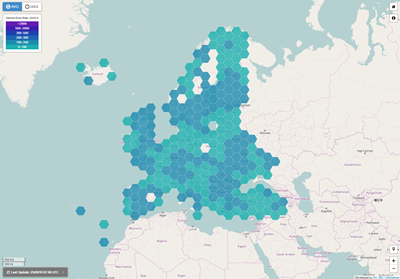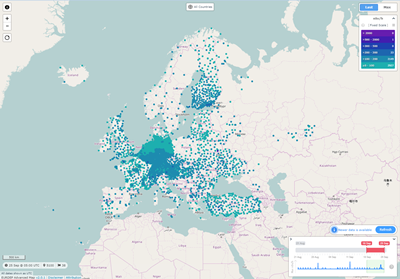The EUropean Radiological Data Exchange Platform (EURDEP) consists of data exchange mechanism and presentation website for radiological monitoring data which is collected and shared by 39 participating countries in almost REAL TIME.
EURDEP is the EU’s official tool for the exchange of radiological data during an emergency but data is exchanged constantly and automatically so that it is available at all times and extra effort in case of an emergency can be minimised.
This data exchange is regulated by both the Council Decision 87/600 (ECURIE Arrangements) and the Recommendation 2000/473/ Euratom.
Participation of non-EU countries is voluntary but participating countries sign an Administrative Arrangement with the European Commission in order to ensure that data delivery will continue also during emergency situations.
EURDEP is developed and maintained by the Joint Research Centre of the European Commission.
During normal (non-emergency) times the data collected essentially reflects the current natural radiation background. EURDEP is not a rapid alert system. The early notification of a radiological accident or emergency is carried out via the European Community Urgent Radiological Information Exchange system (ECURIE) which is operated by the European Commission on a 24/7 basis.
Data exchange
The EURDEP network is used by participating countries for the continuous exchange of data from their national radiological monitoring networks in almost real-time. Participating organisations are required to make routine data available every day but during an emergency a minimum frequency of one hour is required.
Data is collected from the national data servers through dedicated channels. Collected national datasets are mirrored among several geographically separated database servers to ensure high degree of robustness and data availability, especially during a radiological accident.
All incoming data files are checked and aggregated into the common database before being placed in the central database. The participating organisations can subscribe to various notification queues to automatically receive the aggregated datasets with latest monitoring data.
An aggregated data set is also shared with the IAEA on an hourly basis in order to supply the IRMIS system with European data.
Public maps and services
Freely accessible public maps allow viewing the monitoring data in a user-friendly way.
Simple
The availability of the "Simple" EURDEP map was discontinued on 31 July 2023. The "Advanced" EURDEP map on this same page continues to provide public access to EURDEP data.
If you have questions, please feel free to contact the EURDEP team via EC-EURDEP@ec.europa.eu

Advanced
The "Advanced Map" shows measurements of environmental radioactivity in the form of hourly gamma dose rate averages going back up to 35 days. The measurements originate from approximately 5000 stations.
The map displays essential information to explain various environmental radioactivity phenomena, and offers more options for data filtering and analysis. Due to the large amount of displayed data, this map is not very suitable for phone browsers, even if it allows display and usage of the most important elements.
Try it now
Some countries may impose a delay before their data becomes visible to the public.
International collaboration
EURDEP is also a standard format for radiological data submission and exchage between monitoring systems. The latest release of the format is version 2, which is in use since the beginning of 2002. The data-format is applied for participation to the EURDEP network, but also for other national and international systems such as CBSS, MODEM, ARGOS, RODOS etc.
Since 2013 the platform is compliant with the requirements of the International Radiological Information Exchange (IRIX) format, developed by IAEA. The European Commission takes an active part in the development of the IRIX format and its propagation to exchange radiological monitoring data at regional and world-wide scales.
In 2014 EURDEP started the submission of the European radiological data to the International Radiation Monitoring Information System (IRMIS) under provisions given by the Conventions on Early Notification and Assistance in the case of a nuclear accident or radiological emergency (ENAC). In this way EURDEP assures the role of European Regional HUB for IRMIS.
When a picture (video) is worth more than a thousand words...
An explanatory video is also available here:
Stay Tuned
Subscribe information data feeds and be notified about any abnormalities in a close environment.




